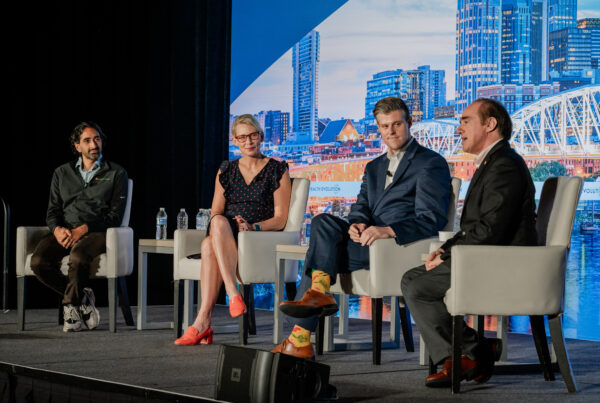This is a time of multiple crises: civil unrest and inequities, high rates of unemployment and growing numbers of uninsured Americans, as well as a turbulent election season amid the deadliest global pandemic in at least a century — and all of these ongoing problems intersect in health care.
Already challenged with large-scale technology implementations and payment model transformation, provider, payer and life sciences CEOs are now facing new and difficult obstacles.
Members of the Health Evolution Leadership Committee discussed working through the chaos to emerge a stronger, more equitable and cost-effective health system. Our Leadership Committee consists of more than 50 influential CEOs, policy makers and thought leaders accelerating change in the industry.
Leadership Committee members indicated that private sector CEOs see the pressing need take a lead now in driving systemic improvements by leveraging peer support in cross-industry collaboration with the purposeful intention of reimaging health care for the future.
Opportunity to drive change
Private sector CEOs are uniquely positioned to lead health care out of today’s crises in ways that the government cannot. That also means they share a burden for accomplishing change in these turbulent times.
“It’s important for private sector CEOs to take on the continued improvement and transformation of health care lest others outside the industry, new entrants or government, do it for us,” said Bruce Broussard, President and CEO, Humana.
To achieve that, three critical imperatives for health care CEOs today are speed, bravery and flexibility, according to Craig Samitt, MD, President and CEO, Blue Cross and Blue Shield of Minnesota.
“Now is not the time to hunker down,” Samitt said. “Instead, we must urgently and quickly pursue value transformation, bravely face the inadequacies of our traditionally non-digital, facility-centric, and inconvenient care system and firmly extend our reach into adjacencies: social health, behavioral health, and wellbeing.”
Rhonda Medows, MD President of Population Health Management and CEO, Ayin Health Solutions of Providence, explained that CEOs often have a unique perspective of the health care industry as well as their individual markets that enables them to innovate and coordinate new partnerships without the bureaucracy often inhibiting public health institutions. With adequate financial resources, they can also lead new avenues of change, notably diversifying business offerings, piloting new technologies and care delivery models. CEOs can also lead in designing and developing proofs of concept that other executives and organizations can expand upon to improve the health care system, Medows said.
“Private sector CEOs can be a catalyst for change,” Medows said. Rick Gates, SVP, Pharmacy & Healthcare, Walgreens Boots Alliance, added: “Private sector companies have the experience, resources and expertise to accelerate change during times of need — but we can’t go at it alone.”
Leverage peer support and cross-industry collaboration
As trying as current conditions are, the crises also present significant opportunities to transform various aspects of the industry, from care delivery to technology utilization to alternative payment models and new uses of patient data such as social determinants and behavioral health.
“Partnerships that enable us to combine the respective areas of expertise are essential to catapult the nation into the future of health care,” Gates said.
Broussard added that cross-industry collaboration is critical to understanding the whole picture of each sector beyond an outsider’s perspective.
“Health care is a very complex business and those who are in it have the depth of understanding of where the greatest opportunities are for improving it and it’s sometimes difficult for those outside the industry to fully understand and appreciate the value that industry organizations provide,” Broussard said.
Gates added that health care executives can also use this opportunity to reconsider the roles their enterprises play in the broader health care ecosystem and in their communities.
Cross-industry collaboration was important prior to COVID-19. America’s aging population is and will continue to be overwhelmed with people who have multiple chronic conditions. Gates said that health care organizations need to determine ways to close gaps in care, improve community care and leverage telehealth to consult with people in rural regions.
“We need to maximize our capabilities to ease the burden on the health care system and create an environment where every patient gets access to the holistic care they need,” Gates said.
Reinvent health care from the inside out
COVID-19 is arguably the most pressing of today’s crises but it will likely be the shortest. Socioeconomic and racial inequities, for instance, will unfortunately outlast the outbreak.
“CEOs need to reassess and recalibrate their business strategies and growth plans to reflect changes in their own liquidity and reserves, market demand, consumer behavior, purchaser preferences and regulatory changes,” Medows said.
Samitt added that CEOs have essentially been rewarded to perpetuate historical models that no longer work and opted against change.
“I’ve long hoped that the health care incumbents will drive the reinvention of health care from the inside out rather than waiting for disruptive innovative or external forces to reinvent us from the outside in,” Samitt said. “We have the way to transform healthcare — we just now need the will.”
[Editor’s note: Health Evolution has expanded its Leadership Committee as it added new offerings, including the Forum, Insights, Insider, CEO Guide, Innovation Lab and series of Executive Briefings and Industry Solutions virtual gatherings. This is the first in the Leadership Perspectives series that will feature Leadership Committee participants sharing outlooks and points of view.]









